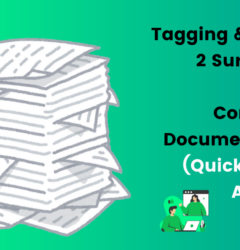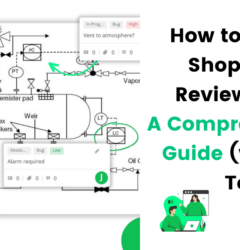How to Reduce Construction Document Errors: Best Practices & Tools for Success
17 Jan
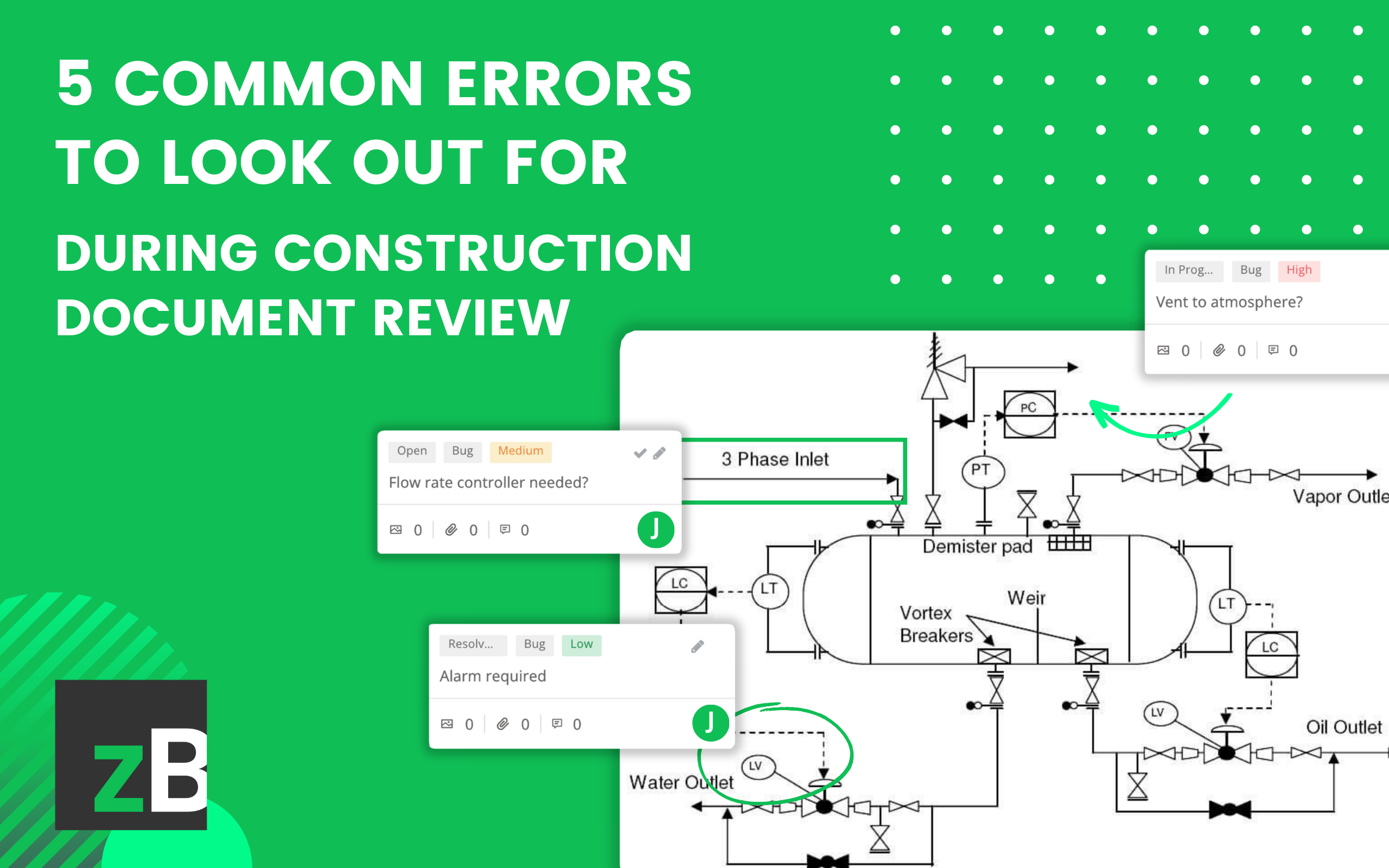
Table of Contents
ToggleConstruction document errors can lead to project delays, costly rework, budget overruns, and safety risks.
Due to the complex nature of construction projects, even small mistakes in construction documents like design plans, specifications, or submittals can create a domino effect that disrupts workflows, causes miscommunication, and leads to significant financial and operational setbacks.
These errors happen for a variety of reasons: overlooked details, outdated information, and poor communication between stakeholders.
While no project is immune, there are ways to significantly reduce these errors by addressing the root causes and implementing better processes. Some of such include adopting strategies and tools that prioritize accuracy, consistency, and collaboration throughout the documentation process.
In this guide, we discuss common documentation-related construction errors and practical strategies on how you can prevent them – using zipBoard.
zipBoard is a construction document management and collaboration software that enhances communication, streamlines document workflows, and provides a centralized platform for real-time collaboration.
Watch the video to see how how zipBoard can streamline your construction documentation review workflows. Start a free trial to experience it first-hand.
9 Common Construction Document Errors and How to Prevent Them & Avoid Delays
Understanding what causes construction project delays often involves identifying documentation gaps, communication breakdowns, and ineffective review processes.
Below is a construction document errors list that highlights some of the most frequent issues teams face and practical ways you can address them:
Poor Communication & Coordination Between Stakeholders
Disconnected communication channels and the absence of a centralized collaboration system often lead to fragmented information sharing.
When your team relies on scattered emails, phone calls, or outdated file-sharing methods, you can miss or misunderstand critical updates. Consequently, this results in project delays, costly rework, and even safety hazards.
According to a PlanGrid and FMI study, 52% of rework in construction is caused by poor communication and misaligned project data, leading to wasted resources and prolonged timelines.
Solution: Centralize all construction documents and communication within zipBoard, where stakeholders can access the most up-to-date information in real time. With a centralized dashboard, everyone is on the same page—whether it’s reviewing changes, providing feedback, or tracking progress. Additionally, collaborative feedback loops and integrated communication reduce misunderstandings and enhance coordination.
Ensure clear and efficient communication on your next construction documentation reviews
Try zipBoard today and keep everyone on the same page. Or book a personalized demo to see how we can help your team.
Get Started for FreeBook DemoIncomplete or Inaccurate Submittals
These are among the most common submittal mistakes, often caused by missing data, non-compliance with codes, or a lack of thorough reviews. Without a clear and consistent process for document management, stakeholders may overlook crucial details, leading to incomplete submittals or mistakes in compliance.
The effect? A delayed document approval process, which potentially puts the entire project timeline at risk. This can also result in costly rework, as mistakes or missing information may require re-submission or corrective actions. In severe cases, legal complications or fines can arise from failure to comply with building codes or contractual requirements.
Solution: Set up a streamlined construction submittal process in zipBoard that incorporates structured document review workflows and clear review guidelines. zipBoard’s document version control ensures that stakeholders review the latest documents. Additionally, multiple team members can give and receive feedback using PDF markup tools in real-time.
Stop letting incomplete submittals delay your projects
Start your free trial with zipBoard and streamline your construction document reviews today.
Get Started for FreeDocumentation Errors in Drawings and Specifications
These occur due to oversights during design reviews or a failure to detect inconsistencies early in the process. When design teams fail to meticulously examine the documents or overlook discrepancies, these errors can go unnoticed until much later in the project.
Construction document errors in drawings and specifications often lead to expensive change orders, requiring costly revisions and adjustments. These errors also result in project delays as teams work to correct the issue, potentially pushing deadlines back and disrupting the overall project timeline.
Additionally, these errors can cause construction defects, which may compromise the integrity of the structure, leading to further delays and increased costs in repairs.
Solution: Use zipBoard’s PDF annotator and document markup tools to collaborate on design documents, identify construction document errors early in the process, and suggest fixes in real time. With clear, visual markups, reviewers can flag errors in drawings or specifications before they become costly issues.
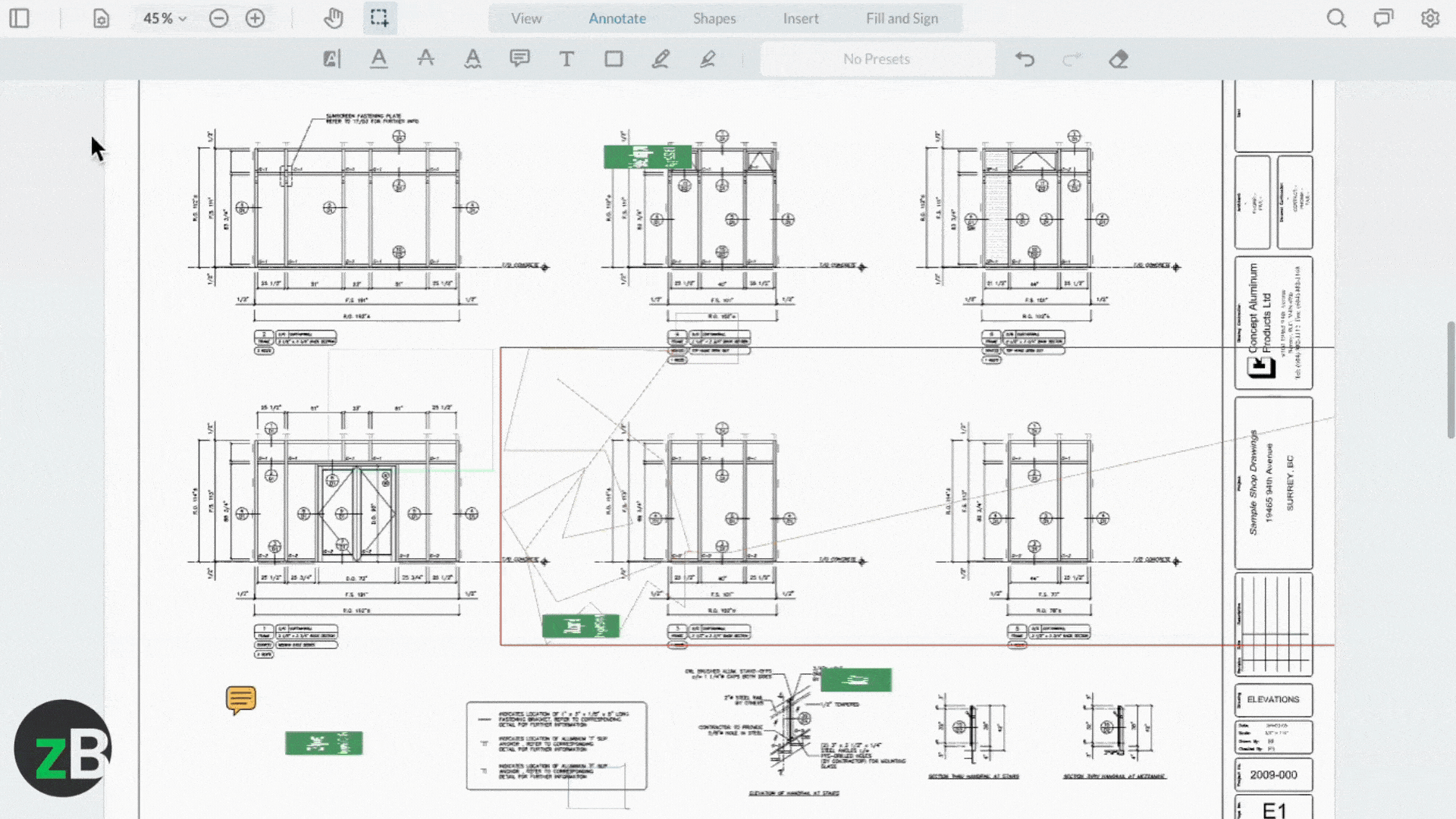
Stop letting incomplete submittals delay your projects
Invite all relevant stakeholders to review and approve construction documents in one place. Start your free trial with zipBoard and streamline your construction document reviews today.
Get Started for FreeBook DemoRelying on Outdated or Ineffective Technology
Outdated technologies like manual progress tracking through spreadsheets and emails, often lead to data loss and version confusion. As your team struggles to keep track of multiple versions of documents across different platforms, it’s easy to overlook or lose track of important information.
These issues create disorganized workflows, making it easier to miss or misplace important documents or updates. As a result, your team can miss deadlines or become inefficient, leading to delayed project timelines. Additionally, poor version control can lead to serious construction mistakes, resulting in crew members using outdated plans on-site.
Furthermore, the increased error rates associated with outdated technology can result in costly mistakes, as you may struggle to collaborate effectively on documents or catch issues in time.
Solution: Replace your legacy document collaboration systems and manual processes with zipBoard. Using zipBoard will give you access to real-time updates, version control, and task management features to ensure everyone is working with the most current information, eliminating confusion and inefficiencies. Additionally, automated reminders and notifications also help keep projects on schedule.
Say goodbye to spreadsheets and long email threads. Use zipBoard for streamlined submittal management.
Get Started for FreeInconsistent Documentation and Contract Information
Inconsistent documentation and contract information often arise from a lack of standardization in document formats and updates. When different teams or contractors use various formats or fail to keep documents current, it leads to confusion about the correct version or the specifics of contract terms, project details, and timelines.
The consequences of inconsistent documentation can be severe. They often lead to confusion among stakeholders, as conflicting information can make it difficult to determine the right course of action. This confusion can escalate into disputes, particularly when it involves contract terms or project scope. Additionally, inconsistent documentation can expose companies to legal risks, as unclear or outdated records might lead to misunderstandings or contractual breaches.
Solution: Use customizable templates and construction submittal review checklists to ensure that all construction documentation is consistent. Subsequently, use zipBoard to manage submittal and other documentation reviews to ensure that all stakeholders are working from the same version of the contract or drawing.
Simplify document management and avoid costly disputes. Keep your project on track with zipBoard-try it today!
Get Started for FreeInadequate Quality Assurance and Testing
Skipping or neglecting quality assurance and testing during the pre-construction or planning phases can lead to costly repairs, defects, or safety issues down the line.
When construction quality assurance processes are not properly implemented or prioritized early on, defects and issues are more likely to be overlooked until the project is well underway.
Failing to conduct thorough QA and testing can lead to construction defects that might only become apparent after significant work has been done. This can result in costly repairs, as well as delays in the project as teams go back to fix mistakes. More importantly, poor quality control can introduce safety hazards, putting workers and the public at risk.
Solution: Create construction review checklists for each construction documentation. Then set up document review workflows in zipBoard to review documents with stakeholders and ensure they meet industry standards.
Strengthen your quality assurance process and prevent costly rework. Start using zipBoard for seamless quality assurance today!
Get Started for FreeBook DemoSkipping Detailed Risk Assessments
Many projects overlook thorough risk assessments during the planning phase, which can lead to unforeseen complications later in the project—complications that delay timelines and increase costs.
Without a comprehensive understanding of potential challenges, teams may overlook critical risks or fail to prepare adequately for issues that could arise later in the project.
The failure to assess risks properly leads to unexpected issues that can disrupt project timelines and create unforeseen obstacles. As a result, projects may experience significant delays, and your teams may have to rework certain aspects of the project. Additionally, these unaddressed risks often lead to budget overruns, as you have to divert resources to fix problems that could have been mitigated with proper planning.
Solution: Use zipBoard to collaborate on risk assessments by centralizing the documentation and assigning tasks for mitigation. A collaborative approach to risk identification and management helps ensure that you don’t miss potential issues. Also, using zipBoard will enable you to track risks and create action plans to address them, preventing surprises down the line.
Identify and mitigate risks before they escalate. Start managing project risks effectively with zipBoard
Try zipBoard for FreeBook DemoLack of Proper Scheduling and Planning
A lack of proper scheduling and planning often results from undefined timelines and poorly allocated resources. When you fail to establish clear timelines or don’t allocate the right resources at the right time, it becomes difficult to manage the project efficiently, leading to bottlenecks and missed milestones.
This disorganization causes missed deadlines, as critical tasks are not completed on time. Resource conflicts may also arise, with teams or materials being double-booked or underutilized, leading to inefficiencies. These issues ultimately result in increased costs, as additional resources or time are needed to compensate for delays or over-allocation.
Solution: Streamline project scheduling in zipBoard by assigning tasks, setting deadlines, and tracking progress in real-time. With task management features, you can ensure that each responsibility is clearly defined and that everyone stays on schedule.
Keep your project on track with zipBoard’s powerful document and task-tracking tools!
Start your free trial today or book a personalized demo. See how zipBoard can optimize your construction documentation and improve project outcomes.
Start Your Free TrialBook DemoBest Practices for Reducing Construction Document Errors
Establish Clear Submittal Guidelines
One of the most effective ways to prevent construction document errors is to define and communicate clear submittal guidelines. Setting documentation standards ensures that all parties involved in the project know exactly what is expected in terms of format, content, and approval processes.
Clear guidelines minimize confusion, reduce the risk of incomplete or inaccurate submissions, and streamline approval workflows, ensuring that the project stays on track from the very beginning.
Standardize Documentation with Templates
To reduce construction document errors and avoid rework, implement standardized documentation practices and thorough review processes throughout every project phase.
Using standardized templates for drawings, submittals, and reports helps eliminate errors related to inconsistent formats. Templates also ensure that all documents follow the same structure, reducing the risk of missing information or misinterpretations.
By creating reusable templates for common documents, project teams can maintain accuracy and efficiency, keeping everything organized and easy to review.
Implement Thorough Review Processes
To catch errors before they become costly issues, it is crucial to implement thorough document review processes. Implementing phased, collaborative reviews allows your team to conduct multiple rounds of detailed checks at different stages of the project.
zipBoard’s document collaboration tools for real-time feedback, markup, and annotation help ensure that all relevant stakeholders review each document or design thoroughly, reducing the chances of missed mistakes and discrepancies.
Streamline construction documentation reviews with zipBoard
Start your free trial today or book a personalized demo to see how zipBoard can optimize your construction documentation and improve project outcomes.
Get Started for FreeBook DemoTrack Deadlines and Responsibilities
Keeping projects on schedule requires tracking deadlines and assigning responsibilities effectively. By using zipBoard’s built-in task manager, you can assign specific tasks to individuals, set deadlines, and track progress in real time.
Additionally, zipBoard’s intuitive interface allows project managers to monitor task completion with auto-generated reports, ensuring that they meet project deadlines and that all stakeholders execute their tasks.
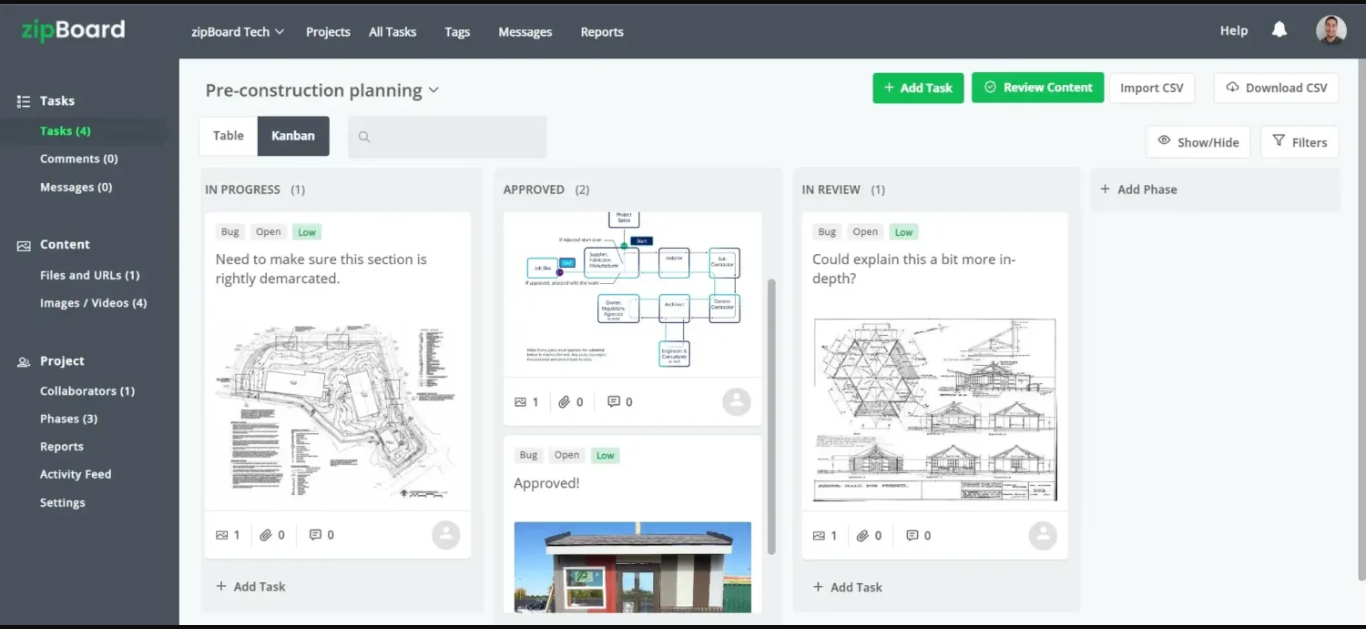
Maintain Detailed Records
Accurate, up-to-date documentation is critical for successful project execution. Using zipBoard’s version control ensures that you maintain accurate records of documents and ensure that all changes are tracked over time.
This eliminates confusion around document versions and ensures that everyone has access to the most current information. Document versioning allows your team to go back and reference previous versions if necessary, providing a comprehensive history of decisions and changes throughout the project.
Learn more about zipBoard’s document version control tool here.
Improve document version control during construction documentation reviews with zipBoard
Start using zipBoard to standardize construction document review workflows, track progress, and reduce costly errors!
Get Started for FreeBook DemoHow Technology Can Help Reduce Errors in Construction Documentation
Technology like construction administration software can significantly minimize construction problems by streamlining document management and improving collaboration. Here are 5 key ways technology can help:
Centralized Document Management
One of the biggest challenges in managing construction documents is the risk of version mix-ups. Multiple teams working on different versions of the same document can easily lead to confusion and errors.
zipBoard’s secure cloud storage centralizes all documents in one location, ensuring that every team member always has access to the latest version. This eliminates the risk of using outdated or incorrect documents, keeping the project on track and error-free.
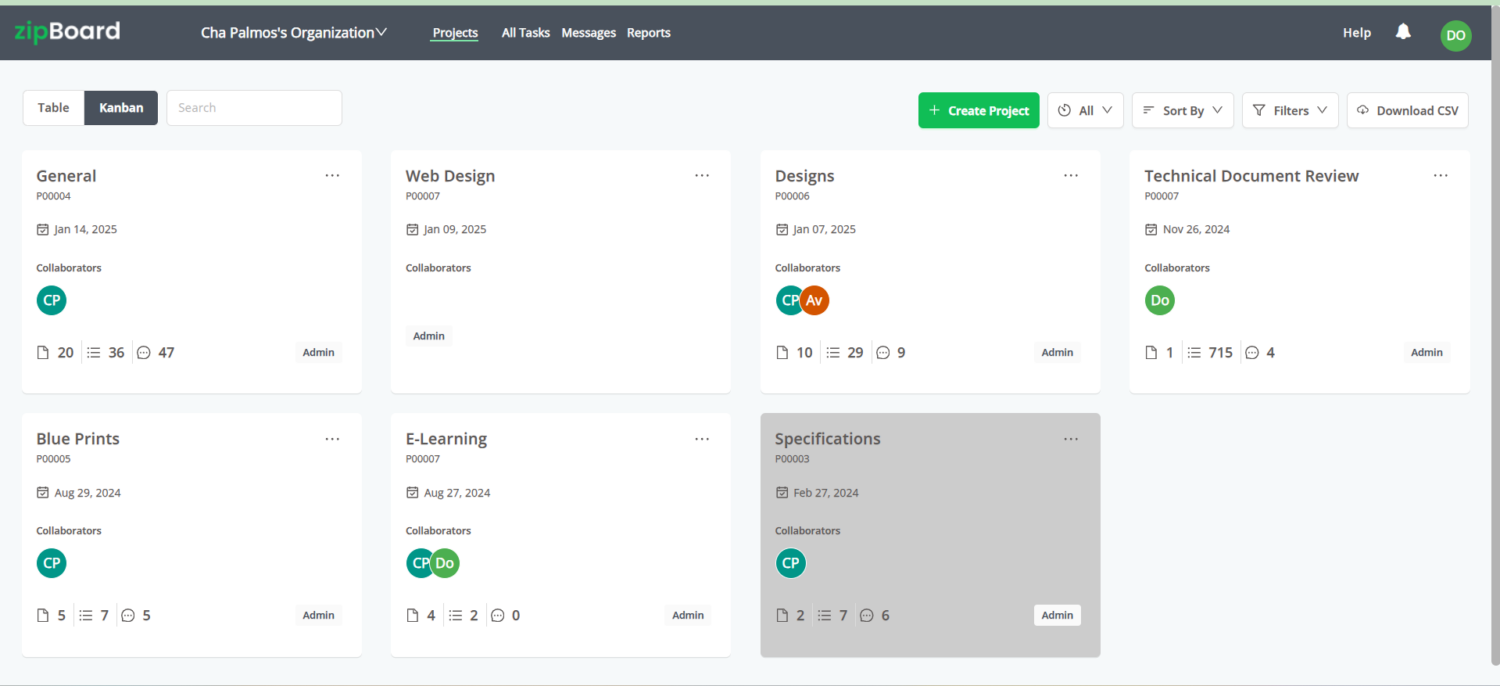
Real-Time Collaboration and Feedback
Effective collaboration is critical in identifying and correcting construction document errors before they escalate. zipBoard’s PDF annotation tools allow team members to mark up documents in real time, providing immediate feedback on designs, drawings, and reports.
This feature facilitates efficient reviews, enabling multiple stakeholders to provide input at once, minimizing delays and ensuring that everyone is aligned on the latest changes.
Automated Workflows and Notifications
Construction projects involve many moving parts, and it’s easy for tasks to fall through the cracks. Automated submittal workflows and notifications in zipBoard help streamline task management by automatically converting feedback into tasks, setting deadlines, and sending reminders.
This ensures that no critical step is missed and reduces the risk of delayed approvals or overlooked tasks. With automated processes in place, teams can focus on the work itself rather than tracking project details.
Integration with Existing Tools
Most construction teams use a variety of tools to manage different aspects of their projects.
zipBoard’s APIs for custom workflows and ability to integrate with existing tools like Slack, Outlook, and MS Teams allows teams to continue using their preferred communication platforms while centralizing their document management and collaboration in zipBoard.
These integrations streamline documentation workflows by bringing project updates, notifications, and collaboration directly into the tools teams already use, reducing the need for switching between platforms.
AI-Powered Auto-Tagging and Smart Workflows
zipBoard’s AI-powered auto-tagging and smart workflows take task management and error prevention to the next level. The AI system automatically tags tasks based on their descriptions and files based on their names, making it easier to categorize and prioritize work.
By automating these workflows, zipBoard ensures that tasks are assigned to the right team members, deadlines are met, and no tasks are overlooked. This enhanced efficiency helps teams stay organized, reduce human error, and keep projects moving forward smoothly.
Ready to eliminate submittal errors and improve project workflows?
Try zipBoard today to experience seamless collaboration and smarter project management.
Get Started for FreeWhy Attention to Detail Matters in Construction Documentation
Prevents Costly Rework
In construction, errors in documentation can often go unnoticed until later stages of the project, leading to costly rework. This can have a significant impact on project schedules and budgets.
zipBoard’s PDF annotation tools enable team members to catch errors early in the design, drawing, or specification phase. By identifying issues while they’re still small, teams can address them before they become larger, more expensive problems, saving both time and money.
Ensures Regulatory Compliance
Adhering to regulatory standards is a non-negotiable aspect of construction. Non-compliance due to incomplete or inaccurate documentation can result in fines, delays, or legal issues
zipBoard allows teams to manage compliance checklists and ensure that every document meets necessary standards. With the ability to track updates and document approvals, zipBoard helps ensure that your project stays compliant and reduces the risk of legal complications down the line.
Enhances Project Coordination
Construction projects involve multiple stakeholders, including architects, engineers, contractors, and clients. Without effective coordination, documentation can easily become fragmented and lead to confusion.
zipBoard promotes project coordination by organizing submittals and keeping all stakeholders aligned.
Through real-time collaboration and transparent communication, zipBoard ensures that everyone has access to the latest, most accurate information, reducing the chances of misunderstandings and miscommunication.
Strengthens Accountability
When roles and responsibilities are unclear, tasks can be overlooked, causing delays and errors. zipBoard strengthens accountability by enabling you to assign tasks to specific team members and track progress.
With zipBoard’s task management features, each team member knows exactly what they are responsible for, and project managers can monitor the progress of every task. This level of clarity helps prevent mistakes from being missed and ensures tasks are completed on time.
See how zipBoard can help your team improve accuracy and accountability in construction submittals
Start your free trial or book a demo today so that we can create a tailored solution for you.
Get Started for FreeBook DemoWrapping Up
Construction document errors, whether related to communication breakdowns, incomplete documentation, or overlooked details, can significantly hinder a project’s success.
They lead to delays, cost overruns, and safety concerns, impacting both the project timeline and the overall quality of the work. These mistakes, if not addressed properly, can even escalate into legal disputes or compliance issues.
zipBoard offers robust and affordable construction submittal management solution to mitigate these errors. Its intuitive platform not only reduces the risk of errors. It also enhances overall project coordination, helping construction teams deliver high-quality results on time and within budget.
Streamline Your Construction Documentation Process and Reduce Errors with zipBoard
Start your free trial or book a demo today so that we can create a tailored solution for you.
Book DemoStart Free TrialFAQs
Common causes of delays in construction projects include poor communication between stakeholders, unclear roles and responsibilities, inaccurate or incomplete documentation, and unforeseen issues like weather disruptions or supply chain delays.
Ineffective technology or outdated systems can also contribute to delays by slowing down workflows and causing confusion in document management.
Contractors can improve the submittal review process by establishing clear submittal guidelines, standardizing documentation formats, and implementing thorough document review procedures.
Submittal review tools like zipBoard enable collaborative review workflows, where stakeholders can mark up documents, leave feedback, and track changes in real-time, ensuring all submittals are accurate and complete before approval.
Poor documentation, whether it’s due to incomplete information, outdated data, or lack of proper organization, can lead to construction document errors. When drawings, specifications, or contracts are unclear, misinterpretations can occur, resulting in costly rework and delays.
Ensuring accurate, up-to-date, and organized documentation helps avoid these errors and improves overall project outcomes.
Technology plays a critical role in reducing construction mistakes by providing tools for real-time collaboration, document management, and automated workflows.
Platforms like zipBoard help centralize project communication, track version updates, and facilitate thorough reviews, ensuring that all stakeholders are on the same page and reducing the chances of errors due to miscommunication or outdated information.
Construction teams can ensure accurate and complete submittals by defining clear guidelines for document submission, using standardized templates for consistency, and leveraging collaborative review platforms like zipBoard
These tools enable stakeholders to track progress, provide feedback, and ensure that all required information is included before submission.
Construction document control refers to the process of managing and overseeing the flow of documents throughout a project, ensuring that they are accurate, accessible, and up-to-date.
It involves version control, secure storage, and efficient distribution of documents to relevant stakeholders.
Effective document control helps prevent errors, miscommunication, and delays during the construction process.
Author’s bio:
Dorcas Kpabitey is a Content Marketing Specialist at zipBoard. She began her content marketing journey alongside her BA in Political Science and Spanish at the University of Ghana. If she’s not tapping away at her keyboard or spending time on Twitter and LinkedIn, she spends her day reading articles, newsletters and books.
Recent Posts
- Best Practices for Efficient Document Reviews and Collaboration December 18, 2025
- MEP Document Management: How to Streamline Reviews & Avoid Rework October 3, 2025
- What Is Online Proofing Software? And Why Content Review Breaks Without It July 11, 2025
- How Laerdal Medical Cut eLearning Review Time by 50% with zipBoard’s Visual Review Tool July 9, 2025
- Why Your Team Needs a Content Feedback System (Not Just Comments in Docs) May 28, 2025
©️ Copyright 2025 zipBoard Tech. All rights reserved.

